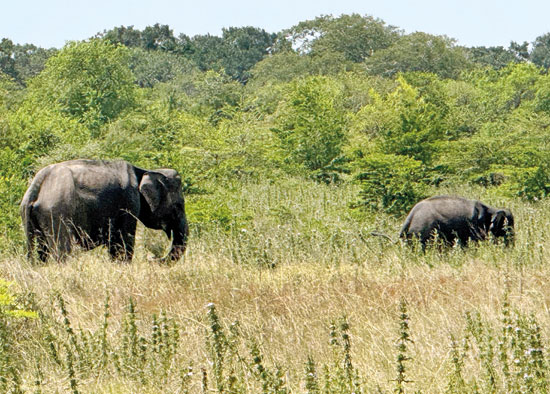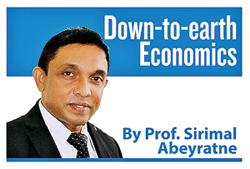Country folks in the cities
View(s):While I don’t intend to revisit last week’s discussion, it is essential to unpack the concept of “urban bias” growth. How does it shape the nation’s economic trajectory? And what does it mean for Sri Lanka’s rural economy and rural people?
Several responses to our previous discussion referenced this controversial claim—one that has surfaced repeatedly in development discourse. These pressing questions form the core of today’s discussion.
Unplanned land use
In 2007, the National Physical Planning Department (NPPD) unveiled a physical plan for Sri Lanka’s future. It projected among other things the emergence of five metropolitan regions by 2030—areas surrounding Colombo, Hambantota, Batticaloa, Trincomalee, and Jaffna—where nearly half of the population was expected to reside.
This initial blueprint evolved into a more detailed and comprehensive physical plan, officially gazetted on June 12, 2019, extending the plan horizon to 2050. It outlined key physical development and transformation, including concentrated urban areas and strategically positioned economic corridors in the country.

Land reserved for wildlife is often given to people who then face intrusions by elephants.
Yet, despite these ambitious proposals, neither plan has progressed beyond conceptual exercises. Sri Lanka’s commitment to physical planning remains questionable, as the country has struggled to effectively manage its limited and environmentally sensitive land resources.
Interestingly, the importance of structured planning was acknowledged even before independence. The Planning Ordinance was enacted, and a dedicated government department was established as early as 1947. However, Sri Lanka has seldom harnessed physical planning as a tool to shape its long-term development trajectory.
Advanced countries
Whether we used physical planning or not, it doesn’t matter. One of the important features of the development process of the country that has been recognized by the above physical plans too, is the concentration of people into dense urban living. In contrast, rural areas become sparsely populated large farmlands and even unpopulated forests.
In highly developed nations such as the U.S., the U.K., and Germany, the rural population has dwindled to just 15–20 per cent of the total, while agriculture contributes a mere 1 per cent to GDP. Even in Australia, where land is abundant and agricultural production is thriving, the sector accounts for less than 15 per cent of GDP.
 Japan presents an interesting case, as regulatory and cultural barriers discourage large-scale land consolidation. Despite these constraints, rural residents make up less than 10 per cent of the population, while agriculture contributes just 1 per cent to GDP.
Japan presents an interesting case, as regulatory and cultural barriers discourage large-scale land consolidation. Despite these constraints, rural residents make up less than 10 per cent of the population, while agriculture contributes just 1 per cent to GDP.
South Korea, which transitioned into a high-income economy after the 1970s, now has only 18 per cent of its population living in rural areas. Employment in agriculture accounts for a mere 5 per cent of the labour force, with the sector contributing just 1.5 per cent of GDP value addition.
Compared to Western nations, Asian countries typically have a higher rural population share and smaller farmlands. Nevertheless, as development progresses across generations, rural populations, agricultural employment, and agriculture share of GDP all exhibit a steady decline.
Chinese problem
Global trends show that as development progresses, populations concentrate in urban areas, while rural regions become increasingly sparse. Many countries actively implement policies, regulations, and strategic plans to accelerate this transition, recognising its role in fostering economic growth.
China serves as a compelling example. For decades, its Hukou system imposed regulatory barriers that restricted rural migration to urban areas. Until recently, despite its rapid growth momentum, over 40 per cent of the population resided in rural areas, with 25 per cent of the labour force engaging in agriculture.
However, this system hindered potential economic transformation and development. Recognising the necessity of urban expansion for sustained economic progress, the Chinese government has introduced urban development initiatives aimed at relocating rural populations to urban centres—particularly along the eastern coastal regions. These efforts encompass urban housing projects, improved public services, and expanded employment opportunities within industrial sectors.
Surviving, not thriving
In contrast to the shifting urban-rural population dynamics observed in the global economy, Sri Lanka remains an outlier. For various reasons, the country’s rural population has persistently hovered around 80 per cent of the total. Over 25 per cent of its 8.5 million labour force is still engaged in agriculture.
Unsurprisingly, over 80 per cent of
Sri Lanka’s impoverished population also resides in rural areas. The issue is clear: Rural agriculture is both low-productivity and low-reward, with too many farmers competing for livelihoods on too small farm plots. While their efforts ensure survival, they seldom lead to prosperity.
This problem is deeply rooted in
Sri Lanka’s historical development trajectory. The country has not only neglected national-scale physical planning—which could strategically define settlement patterns—but has also fostered conditions that encourage people to remain in rural areas through various incentives.
Politicians, in particular, play a significant role. They frequently clear government-owned land, including forests and protected reserves, parceling it into small plots for distribution. Rural housing initiatives and welfare handouts further reinforce settlement in these areas. Yet, fundamental services, economic opportunities, and infrastructure remain inadequate for a dignified life or productive employment.
As a result, rural residents in such areas often endure relentless struggles—not only to secure basic necessities and public services but also to cope with natural disasters and wildlife threats. However, the incentives they receive, and the absence of viable urban alternatives keep them tethered to these isolated environments.
Urbanisation vs. development
As economies undergo transformation and development, populations tend to concentrate in urban areas, while rural populations gradually decline. Global trends suggest that this shift is development-friendly, reinforcing the reciprocal relationship between urbanisation and economic progress.
Urbanisation fuels development, and development, in turn, accelerates urbanisation. One key driver of this trend is the availability of non-agricultural employment opportunities in urban centres. With better access to education and skill development, individuals find more promising career prospects in industry and service sectors, which are predominantly located in urban environments rather than remote rural areas.
Beyond employment, urban areas also offer a higher quality of life and improved living standards. Cities provide essential infrastructure, efficient transportation networks, educational institutions, healthcare facilities, sanitation services, entertainment options, and utilities—amenities that are often scarce in rural regions.
Even from a government perspective, urban concentration enhances the efficiency and effectiveness of development expenditure. Instead of allocating resources to scattered rural households, which require extensive infrastructure investments for limited populations, governments can optimise spending by delivering essential services to densely-populated urban communities.
Benefit of rural migration
One of the persistent challenges in domestic agriculture has been the dominance of small-scale farmlands, which often struggle with low productivity, weak competitiveness, and limited profitability. However, rural migration to urban areas creates an opportunity for “entrepreneurial farmers” to consolidate land, either by purchasing or leasing plots from others, transforming them into commercial farmlands.
This shift can be driven by natural market forces or strategic government interventions.
As a result, agricultural productivity is expected to rise rather than decline. However, the expansion of urban-based industries and services outpaces agricultural growth, leading to a decreasing economic share of agriculture while the non-agriculture sectors continue to dominate.
Additionally, not all rural villages remain viable economic entities. Some may gradually vanish, reverting to forests and expanding the country’s natural reserves – just like Leonard Woolf’s “Village in the Jungle” (1913), swallowed by the jungle itself.
This transformation is crucial for mitigating human-wildlife conflicts and fostering environmental conservation. By enhancing biodiversity and reducing carbon emissions, this transition benefits both ecosystems and human populations. Ultimately, both people and wild elephants will also have a peaceful life without fighting for the territory.
(The writer is Emeritus Professor at the University of Colombo and Executive Director of the Centre for Poverty Analysis (CEPA) and can be reached at sirimal@econ.cmb.ac.lk and follow on Twitter @SirimalAshoka).
Hitad.lk has you covered with quality used or brand new cars for sale that are budget friendly yet reliable! Now is the time to sell your old ride for something more attractive to today's modern automotive market demands. Browse through our selection of affordable options now on Hitad.lk before deciding on what will work best for you!


